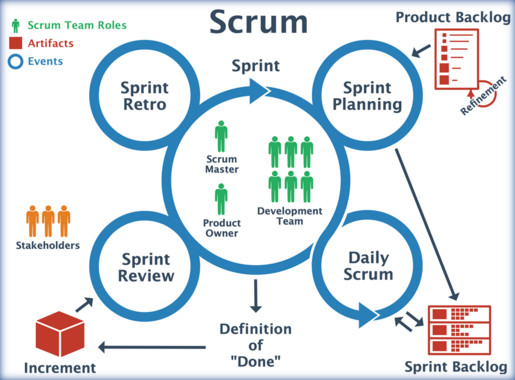
Scrum Explained - In Simple, Plain English without Jargon
The purpose of this article is to explain Scrum in a simple manner using non-technical and Plain English words.

Context
The standard reference document for Scrum is the Scrum Guide. It is a short document (only 16 pages) but is densely packed with Information and uses various Scrum Related terms (Roles (3), Events (5), Artifacts (3)).
If you are not familiar with Scrum or if you need to explain Scrum to someone from the business or a normal person you may find it challenging.
So I have decided to write a few sentences in simple English language. This makes it easier to understand and/or explain Scrum. I strongly advise you to read the Scrum Guide. This article is not a replacement for the Scrum Guide but can be helpful in understanding or explaining the basics. To make it easier for those who are familiar with Scrum I have cross referenced each statement with the relevant Scrum Guide Role / Artifact / Event / Values in parentheses. Ignore the bits in parentheses if explaining to someone who is not familiar with Scrum.
Inspiration for this Article came from an original post from Steve Denning.
So here we go:
1. Work is done in small teams (3 to 9 typically) where the team has all the necessary skills to develop products (Cross Functional teams).
2. Work is planned and executed in short cyclical time frames typically 1 to 4 weeks - Cycles (Sprint) (also called Iteration in general Agile terminology).
3. Only one person decides the work priorities - not a committee or a group (Product Owner via Product Backlog).
4. The team works in an un-interrupted manner during the cycle (Sprint Planning / Sprint Goal).
5. The team gets market information and customer needs from either the customer directly or from someone representing the customer (Product Owner).
6. Only the team can decide how much work it can do in a given Cycle (Sprint Planning / Sprint Goal / Sprint Backlog).
7. Only the team decides HOW it can get the work done (self organisation).
8. The team gets Clarity on WHY it is doing WHAT it is doing before starting the work (Sprint Goal).
9. The team regularly / immediately gets feedback from customers / stakeholders on how well the developed product is meeting the customer needs (Sprint Review).
10. Team continuously improves by reflecting on its practices and behaviour and learning from mistakes regularly (mostly Retrospective / Review but all Scrum events provide feedback).
11. The whole team collaborates while working on a customer need (User Story - Cross Functional).
12. Blockers are immediately raised and discussed on a daily basis if not more frequently (Daily Scrum).
Hope that helps.
Would appreciate comments / feedback. Kindly share it if you find this useful. Thanks.
Regards
Ramki Ravulapalli
Director of Project Management at Acorns
1moHey Ramakrishna (Ramki) Ravulapalli - I appreciate that you used my Scrum diagram, but you removed my attribution and didn’t ask permission to do so. Please replace the image with one with attribution, add a link to my original blog post, or remove the image. You can find the original image with attribution here: https://jordanjob.me/blog/scrum-diagram/
Thank you. Quite inspireing. Wonder if the proces setup would translate into developing teaching practises...
Technical & Customer Support Representative| AWS Certified Cloud Practitioner| Solutions Architect (In View) | Technical Writer |Exceptional Executive Assistant
1yWhile working on an article on Project Management, I came across Scrum and I decided to delve further. This helps.. Thanks a lot
Founder & CMO | B2B Marketing Expertise | Digital Marketing | ASO
3yBeing a scrum master is not an easy task. The job comes with a number of responsibilities, challenges and hurdles that must be addressed by the scrum master. Being a Scrum Master means that you are capable of handling agile teams successfully. Scrum Master Certifications shows that you have the right skills and knowledge that are required for running agile teams in an organized manner. For CSM Certification: https://www.takethiscourse.net/csm-exam/